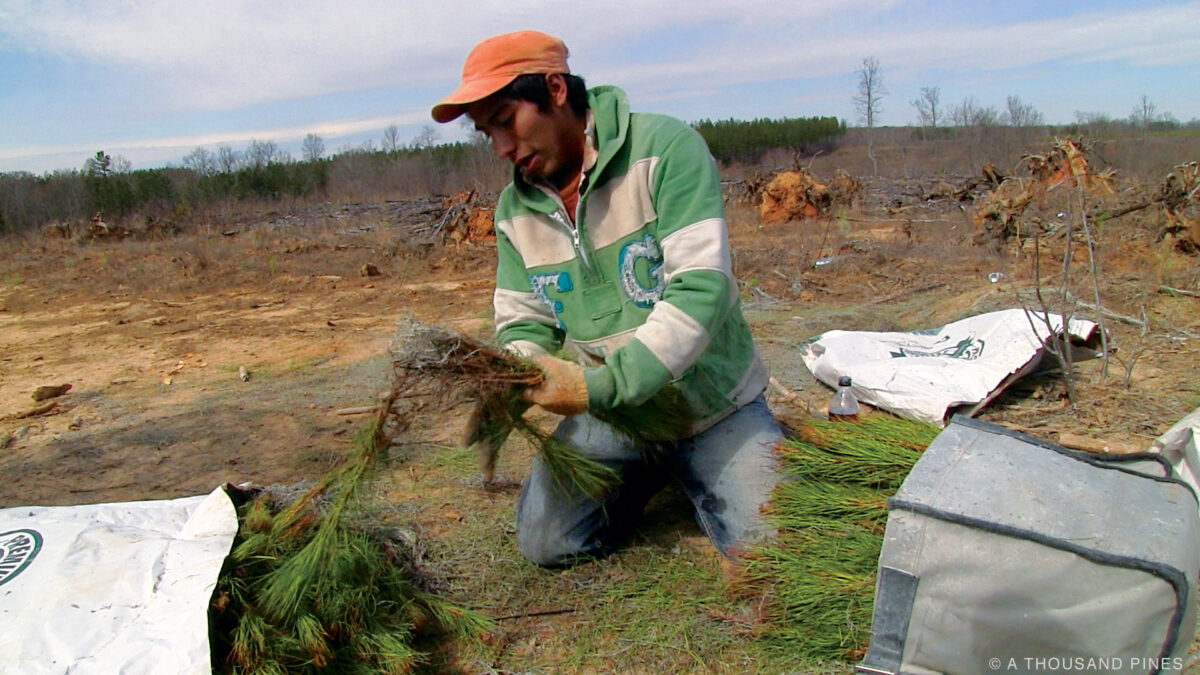
The first Penn student to submit a film as a doctoral dissertation has transformed it into a moving portrait of unsung labor.
The first time he carried his camera down to Georgia to film Mexican tree planters on the job, Noam Osband Gr’17 planned to plant pine saplings alongside them. It was 2013, and the anthropology graduate student aimed to become the first in Penn history to submit a film as a doctoral dissertation. Osband had raised seed money in what you might call the new-fashioned way: after winning $27,799 as a Jeopardy contestant during his first year at Penn, he bagged $250,000 two years later on Who Wants to Be a Millionaire [“Gazetteer,” Jan|Feb 2015].
The men he joined in Georgia, who’d come primarily from Oaxaca on H-2A visas, stood to earn about $400 per six-day workweek—though they universally hoped to make more by exceeding quotas. Provided they avoided injury, the strongest—and strongest-willed—could plant upwards of 4,000 saplings per day in good conditions. Beginning in early winter in the southern US, they would work their way north over the course of an eight- to nine-month season, planting for timber companies and landowners in the lumber and wood pulp industries.
“I lasted two weeks,” Osband recalled. Each day in the fields—where conditions were more often swampy or briar-choked than good—left him shattered with exhaustion by the time it came to shoot footage and conduct interviews. It was impossible to do both, because planting pines at such an intense rate was barely possible to begin with.
He fretted that exchanging his dibble bar and sapling satchel for a lightweight video-camera would crater whatever credibility he had. “How are these guys not going to hate me?” he thought. But the budding anthropologist found a way to endear himself to the crew. Apart from cramming into the same cheap motel rooms (bedding down with a first-year planter who slept diagonally) and eating the same food (beans and hot dogs cooked over a Sterno burner one night, frozen microwave burritos the next), Osband became “El Aguador,” filling his knapsack with water bottles and delivering them to the migrant laborers throughout the day.
The Waterboy defended his dissertation—a three-hour film examining three distinct corners of the tree-planting industry in the US and Canada, supplemented by a 40-page paper—in 2017. Seven years later, he has retailored one thread of that project into a documentary titled A Thousand Pines. Focusing on the Oaxacan migrant laborers with whom he embedded, it aired on April 1 on PBS after appearing in roughly a dozen film festivals. It will be screened during the Philadelphia Latino Arts & Film Festival in May.
The 73-minute feature documentary is a far cry from the heavily narrated, copiously footnoted scholarly video with which he earned his PhD. (John Jackson, the Richard Perry University Professor of anthropology and Penn’s current provost, was an academic advisor on the first effort and is thanked in the credits of the second.) Osband and codirector Sebastian Diaz Aguirre distilled hours of the original footage into a taut narrative. Two men supply its emotional center of gravity: 20-season veteran Raymundo Morales, the crew’s foreman; and his nephew Rodolfo, a first-timer who took out a loan to finance the trip after having fallen into debt to pay for his daughter’s birth by caesarean section.
The documentary offers a stark portrayal of the labor these men do and the sacrifices they make to do it. Planting pines by the thousand in all kinds of weather is punishing work. Long-term separation from the families they do it for exacts a heavier toll. Yet the film also extends its sympathy to their paymasters. Through interviews with the founders of two forestry-services companies, Osband and Diaz illuminate the industry’s transformation from a “counterculture occupation” powered by back-to-the-land hippies in the 1970s into a locus of hard-nosed corporate competition where profit margins depend heavily on Latino migrant laborers holding temporary agricultural visas. The result is a subtle and moving portrait of hard work, in all its complexity.
Struggling through mud by day, plucking thorns from each other’s hands by night, wiring cash to wives and mothers to settle hospital bills back home, these men become family to one another. A dark mood in one man’s breast can infect the entire group. A bright one can fill the frame with tenderness. Osband shows workers staggering beneath the weight of their double-bag sapling satchels, and massaging ointments into each other’s backs and necks at night. He captures the disillusionment produced by a paltry paycheck after a week struggling to pierce frozen ground, and the obvious pride these men derive from improving their families’ prospects back in Mexico—where the minimum wage is $6 per day and domestic agricultural workers are fortunate to earn $70 per week.
“It’s backbreaking work,” Osband said in an interview, and it pays far less than when young Americans were the ones doing it in the 1970s, camping for free on timber-company land. “But it really does provide economic mobility. You go to the rural countryside in Oaxaca, and you can tell who’s worked in the US, in what’s usually a difficult job, because they have a nice house. And they can buy land.”
Viewers who come to A Thousand Pines seeking capitalist triumphalism, however, will be just as disappointed as those itching for a diatribe against labor exploitation. Modeling his approach after the documentarian Errol Morris, “who does not tell you what to think in any of his films,” Osband steers clear of polemic or propaganda. In so doing he paints an exceptionally humane portrait of a class of men who are often treated as one-dimensional objects of fear, pity, and any number of other sentiments directed at low-skilled immigrant laborers. By turns unsettling and inspiring, the documentary does more to illuminate the reality of seasonal migrant labor than any op-ed column, cable TV pundit, or presidential debate in recent memory.
“For my family, I give my life,” says Raymundo, explaining the motivations that spurred him to leave his wife and children nine months of every year for two decades. “When you want to get ahead you leave, and that’s what I did.”
Hundreds of crews like his ply the US between January and August each year, collectively planting 1.5 billion saplings annually. Anyone who changes a baby’s diaper, opens a cardboard box, rosins a violin bow, swallows a slow-release medicine capsule, or reads a magazine benefits from their unseen labor. Osband does them, and us, a service by lifting it into the light. —TP




